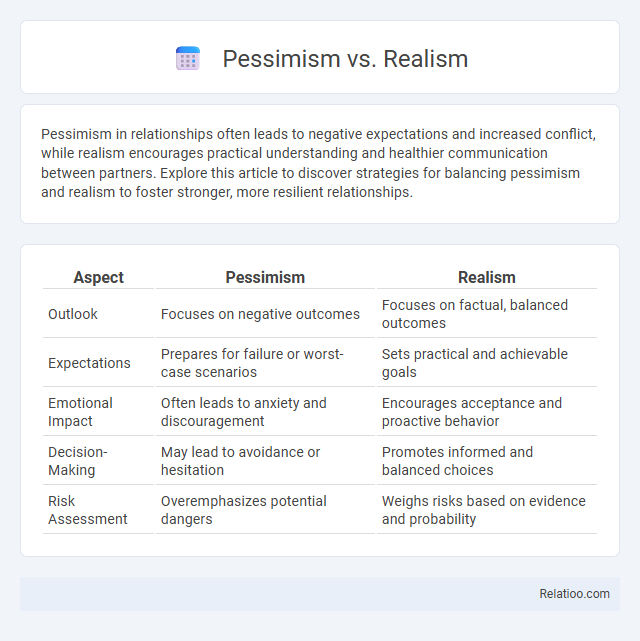Pessimism in relationships often leads to negative expectations and increased conflict, while realism encourages practical understanding and healthier communication between partners. Explore this article to discover strategies for balancing pessimism and realism to foster stronger, more resilient relationships.
Table of Comparison
| Aspect | Pessimism | Realism |
|---|---|---|
| Outlook | Focuses on negative outcomes | Focuses on factual, balanced outcomes |
| Expectations | Prepares for failure or worst-case scenarios | Sets practical and achievable goals |
| Emotional Impact | Often leads to anxiety and discouragement | Encourages acceptance and proactive behavior |
| Decision-Making | May lead to avoidance or hesitation | Promotes informed and balanced choices |
| Risk Assessment | Overemphasizes potential dangers | Weighs risks based on evidence and probability |
Understanding Pessimism: Definition and Traits
Pessimism is characterized by a tendency to expect negative outcomes and focus on potential problems, often leading to a cautious or skeptical outlook. Key traits include a heightened awareness of risks, a focus on obstacles rather than opportunities, and a belief that adverse events are more likely than favorable ones. Unlike realism, which objectively assesses situations without emotional bias, pessimism leans towards a negative interpretation of reality.
Realism Explained: What Sets It Apart?
Realism is grounded in an objective assessment of facts and tangible evidence, distinguishing itself from pessimism's tendency to expect negative outcomes and optimism's hopeful outlook. It prioritizes practical solutions based on current realities rather than emotional biases or unfounded positivity. By focusing on what is achievable and probable, realism fosters balanced decision-making and effective problem-solving in complex situations.
Core Differences Between Pessimism and Realism
Pessimism views situations with a consistently negative outlook, expecting unfavorable outcomes regardless of evidence, while realism assesses circumstances based on objective facts and probabilities, maintaining neutrality without bias towards optimism or pessimism. Core differences lie in mindset: pessimism emphasizes the likelihood of failure and hardship, whereas realism prioritizes practicality and accuracy in judgment. Understanding these distinctions is crucial for decision-making processes in fields like psychology, risk assessment, and strategic planning.
Psychological Roots of Pessimism and Realism
Pessimism often stems from cognitive biases such as negative attributional style and learned helplessness, where individuals consistently expect adverse outcomes based on past experiences. Realism, grounded in accurate perception and evidence-based evaluation, involves balanced cognitive processing without distortion or emotional interference. Psychological resilience and adaptive coping mechanisms differentiate realism from pessimism, enabling realistic thinkers to maintain objective assessments even under stress.
Effects on Decision-Making and Problem-Solving
Pessimism often leads to cautious or avoidant decision-making due to expectations of negative outcomes, which can hinder problem-solving by limiting risk-taking and innovation. Realism promotes balanced decision-making by accurately assessing facts and potential consequences, enabling effective problem-solving through practical and evidence-based approaches. Optimism encourages proactive decision-making and creative problem-solving by highlighting potential opportunities and positive outcomes, fostering resilience and motivation.
Impact on Relationships and Social Interactions
Pessimism often leads to negative expectations that can create tension and mistrust in relationships, diminishing social support and emotional intimacy. Realism fosters clear-eyed understanding of situations, promoting balanced communication and healthier boundaries, which enhance mutual respect and trust in social interactions. Your ability to adopt a realistic outlook helps you navigate social dynamics more effectively, encouraging authentic connections without the distortions of excessive optimism or pessimism.
Pessimism, Realism, and Mental Health
Pessimism often magnifies negative outcomes, potentially exacerbating stress and anxiety, which can harm your mental health. Realism, by contrast, encourages a balanced view of situations, helping manage expectations and fostering resilience. Embracing realism supports mental well-being by promoting adaptive coping strategies and reducing emotional extremes.
Common Misconceptions and Stereotypes
Pessimism is often mistakenly equated with negativity and defeatism, while realism is commonly confused with cynicism or lack of hope. You may believe realists simply accept harsh realities without optimism, but true realism involves objective assessment free from emotional bias. Stereotypes blur these distinct perspectives, overlooking how realists balance practicality with informed expectations, unlike pessimists who disproportionately emphasize potential failures.
Strategies for Balancing Realism and Optimism
Balancing realism and optimism involves integrating accurate assessments of challenges with positive expectations for outcomes, which enhances decision-making and resilience. Effective strategies include setting achievable goals based on realistic appraisal of resources, maintaining flexibility to adapt plans as new information arises, and fostering a growth mindset that views setbacks as opportunities for learning. Cultivating emotional regulation and practicing gratitude further support sustaining optimism without ignoring potential risks or difficulties.
Cultivating a Healthy Perspective: Practical Tips
Balancing pessimism, realism, and optimism requires cultivating a healthy perspective that acknowledges challenges without ignoring opportunities. You can achieve this by practicing mindfulness, setting realistic goals, and reframing negative thoughts to focus on actionable solutions. Regular self-reflection and seeking feedback help maintain a grounded outlook that enhances decision-making and emotional resilience.

Infographic: Pessimism vs Realism
 relatioo.com
relatioo.com